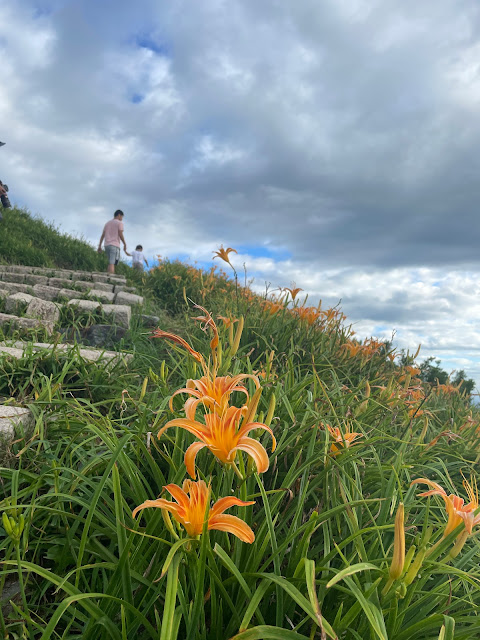2022/08/23-25
My husband got the new job, and we had only one month to move to North. We decided to store our belongings at parents-in-law's place as it was closer, and then we drove from Miaoli to Yunlin to move the most important items first. We had a few days left before my husband started his new job, so he wanted to take a trip to the east of Taiwan. However, I was not feeling well and didn't have the mood and energy to travel. A few days later, I found out that I had contracted COVID-19...
During our trip to Hualien, we made a short stop at Dongshan River Ecological Park in Yilan. After exploring a while, we drove to Hualien, where we stayed for two days. We met up with my husband's friend and went out together a few times. The highlight of the trip was visiting Liushidanshan to see the blooming daylilies. His friend took us for an ATV ride on the beach in Hualien, which was fun, although I didn't enjoy getting covered in sand and dust.
On the morning of the third day, we visited Jian Shrine and then continued driving South. We stayed one night in Taitung to rest before heading back home. By the morning, I was feeling more tired and didn't have the energy to continue. We only made a short stop at Zhiben Waterfall in Taitung before driving back.
As we drove, my fatigue worsened. My husband thought I was dehydrated because the weather was hot during those days, and he suspected I had heatstroke. We made a stop in Yunlin at my parents-in-law's place to pick up some things and then drove to Miaoli. I sat on the sofa feeling half-dead and eagerly waited to go home.
The next morning, I woke up with body pain. I still managed to do the laundry (which was extremely difficult as I could barely move). I didn't have apetite and couldn't stand up, so I decided to take a COVID-19 test, which came back positive.
It finally explained why I didn't enjoy the trip to the east of Taiwan, which had always been my favorite thing to do. I honestly can't remember many things from the trip; I only know that everything bothered me those days, and the food didn't taste as good as it used to.
~ ~ ~
Daylilies at Liushidanshan (六十石山 金針花)
On the 3rd day of our trip, we visited Liushidanshan, famous for its golden Daylily flowers (金針花). Although this year the blooming wasn't as abundant, with many places having few flowers, it still had a certain beauty.
Even in the hot season of August and September, Liushidanshan offers a quiet and mysterious landscape that is attractive, especially during sunset and sunrise. In the evening, you can enjoy a starry night sky and the night view of the east valley. In winter, the rapeseed flowers create a golden carpet in the rift valley. After witnessing the breathtaking sunset from the mountaintop, it's a great experience to relax in the Antong Hot Springs (安通溫泉) below Liushidan Mountain, making it a wonderful destination in eastern Taiwan.
Best time to see flowers: August to September
Ideal time for "cloud gap light" (Jesus light): 15:00-17:00
Sixty Stone Mountain, Chike Mountain, and Taimali Mountain are the three major areas in the East Rift Valley known for their golden daylily plantations. They are popular places to appreciate the vast sea of golden needle flowers every year from August to September. Sixty Stone Mountain (Liushidanshan) is situated on the coastal mountain range, approximately 800 meters above sea level on the east side of Zhutian Village, Fuli Township. After driving along a winding mountain road, you'll be greeted by an expansive field of golden needle flowers, with scattered farmhouses and pavilions.
Why is it called Sixty Stone Mountain? According to the locals, during the Japanese occupation period, the average yield of millet in each paddy field was only about 40 to 50 stones. However, the paddy fields in this area were able to produce 60 stones, hence the name Sixty Stone Mountain. Another theory suggests that during the Japanese occupation period, this mountainous area was once covered in a lush camphor forest, which was cut down for camphor production. It was discovered that there were 60 huge stones scattered on the bare hillside, leading to the place being named Sixty Stones Mountain.
To provide tourists with up-to-date information on flower conditions, the Management Office of the East Rift Valley National Scenic Area has installed a high-resolution camera called "Sixty Stone Mountains - 4K Real-Time Image," offering 4K ultra-high image quality with a 270-degree viewing angle.


























0 komentarze:
Post a Comment